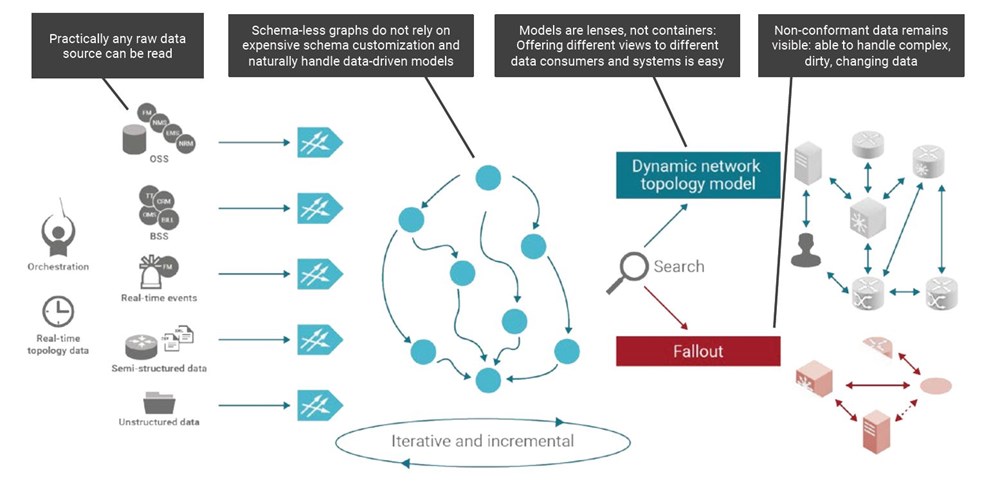Enabling inventory transformation with unified topology
Are inventory silos slowing down your automation and transformation efforts? Should you federate or consolidate? Learn how a flexible topology model overlay can deliver unified and reliable inventory data at a fraction of the cost and risk.
Automating provisioning processes, relating customer experience to infrastructure issues, developing holistic network security – what do these business processes have in common? They all depend on the data quality of network inventory systems.
Communications service providers (CSPs) rely on network inventory systems to support key activities such as service provisioning, planning and network asset management. A network inventory provides a record of what is deployed in the network, how it is being used and locates it centrally in a single application. Without network inventory systems, processing a customer order through to setting up the service delivery in the network would be daunting.
Yet inventory systems have long frustrated CSPs for historical, business and organizational reasons. For instance, inventory data is frequently spread across multiple silo systems and Excel spreadsheets! As a result, service providers struggle with the burden of disjointed IT and network management systems and lack quality data.
- Only 15%1 have an accurate view of network and services inventory.
Poor data quality prevents a full 89% of operators from completing automation projects. - Incorrect and incomplete inventory data causes a 44%2 fallout rate in automated provisioning.
- Operating with fragmented information and systems results in higher OPEX and lower revenues.
Unified inventory for digital transformation and automation
Any service provider that makes digital transformation efforts to automate processes must have a reliable and unified view of inventory data. Automated processes depend on accurate inventory systems that are aligned so that they provide quality data in a unified way. What is the best way for CSPs to achieve this goal?
Inventory consolidation programs that centralize data sets to support unified information views are often prohibitively expensive, take a long time to deliver and turn out to be riskier than originally thought. Many of these traditional waterfall programs take years to deliver value or fail outright due to rigid data modelling and incompatible data systems.
This approach is falling out of favor with CSPs due to the complexity of designing and creating a new “single inventory” system and the effort of managing multiple migrations from source systems.
Federation of multiple inventory systems
If the main goal is to achieve unified data views, data federation, an established and pragmatic alternative, offers a shorter payback time, lower costs and less risk than inventory consolidation. Legacy inventory systems remain in place “under” an overlay that accesses necessary data from each system to build and serve the unified data views required for use cases and business processes.
Inventory federation projects are difficult, especially when they involve merging information from many sources. Maintaining the legacy systems in place also ensures that local feature sets and process support can be maintained as needed. Despite all this simplification, evidence shows that, on average, 71% of federation projects fail to fully deliver, with projects lasting between 3 and 5 years. Nonetheless, this is currently and by far the preferred approach compared to the alternative of consolidation.

Schemaless graph technology in Nova Context simplifies data exploration and handling of dirty data sets.
This is where Nova Context makes a real difference, since it’s engineered to provide essential features that efficiently deliver a logical overlay of unified data views. The semantic engine is the crucial component that handles “repeat information,” taking care of data set translations and transformations. By leveraging data inference and enabling effective reconciliation, Nova Context delivers a logical overlay that is more accurate than the sum of its underlying sources. The solution has helped a number of customers successfully deliver inventory data federations.
Even if you do invest in consolidation, Nova Context topology modelling can help with data migration, or for data reconciliation between systems in order to improve data quality.
Nova Context supports customers as they federate inventory data by providing crucial unified topology references to support next-gen processes and the agility required for digital transformation. It helps improve the accuracy of inventory data by delivering effective reconciliation and data quality management. If data migration cannot be avoided, Nova Context effectively helps streamline and manage the process.
1 Heavy Reading 2019 global operator survey
2 As reported by Centurylink after Nova Context was deployed.



